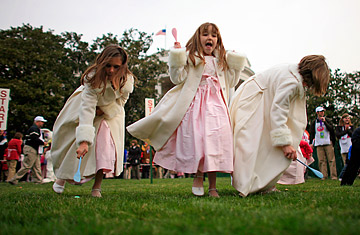
A little girl cheers during the annual Easter Egg Roll on the South Lawn of the White House March 24, 2008 in Washington, DC.
While much of the country spends the day after Easter sweeping up plastic grass and nursing a Peeps overdose, the White House welcomes an invasion of children. Thousands of young people will stream onto the South Lawn this Easter Monday for the White House Easter Egg Roll, one of the oldest presidential traditions and the largest annual event held at 1600 Pennsylvania Avenue. (See top 10 things you didn't know about Easter.
The daylong celebration transforms the presidential yard into official Washington's version of an amusement park, with food, games, music, storytelling, and, yes, thousands of eggs. The President and first lady generally attend, along with other notables ranging from Beltway celebs (Attorney General Janet Reno read attendees a story called "Queen Janet from the Bunny Planet" in 1997) to full-on stars (the Jonas Brothers performed last year). And, of course, there is egg rolling — a European custom of murky origin wherein a hard-boiled egg is pushed, dragged, flung or otherwise propelled across a lawn with a long-handled spoon. Every child leaves with a wooden souvenir egg bearing the printed signatures of the day's hosts, the President and first lady. (See pictures of colorful religious festivals.)
Washington's young people used to gather on the Capitol grounds for Easter Egg rolling in the 19th century, but lawmakers grew so peeved at the damage to the grass that in 1876 they passed the Turf Protection Law banning the practice. Bad weather nixed egg rolling the following year, but in 1878 President Rutherford B. Hayes opened the White House grounds to the displaced youngsters and a tradition began. It has continued steadily ever since, interrupted only by inclement weather and hiatuses during World Wars I and II.
Some 53,000 people attended the egg roll in 1941 (73 children ended up being separated from their parents), though in modern times the number is generally under 20,000. Calvin Coolidge's wife mingled through crowds while holding a pet raccoon named Rebecca, while Mrs. Warren G. Harding put on the uniform of her beloved Girl Scouts for the event. Ursula Meese, wife of Reagan's Attorney General, donned a full-body Easter Bunny costume for six Easter Egg Rolls. Showcasing modern technology, Eleanor Roosevelt welcomed crowds and addressed listeners across the country via radio in 1933, while the Clinton administration proudly announced that 1998's egg roll would be the first broadcast on the Internet.
Washington being Washington, politics is rarely far from the celebration. Nancy Reagan personally called an 11-year-old girl to invite her to 1984's roll after learning that a campaign worker said the girl wouldn't be welcome due to her support for Walter Mondale. More than 100 same-sex couples showed up at the event in 2006 with their children in an organized effort to show President Bush "that gay families exist in this country," in the words of one organizer; critics accused them of "crashing" the event. The Obamas specifically welcomed gay families this year, distributing tickets directly to gay rights organizations. Another innovation of the Obamas: this year's souvenir egg is designed to be environmentally friendly, using vegetable oil-based ink and wood from "sustainably managed forests."
Also for the first time, tickets to this year's event were distributed over the Internet rather than via the first-come, first-served system that traditionally spawns serpentine lines of parents around Washington's Ellipse. The switch was designed to encourage visitors from around the country — families from at least 45 states are expected to attend — though huge demand for tickets left many parents frustrated and empty-handed, despite spending hours in front of their computers. A reminder, perhaps, that this particular rite of spring is designed primarily for the enjoyment of children, not grown-ups. As former Clinton adviser Bruce Reed, a seven-roll veteran, told the New York Times: "It was an experience that you wouldn't want to miss, but it was absolutely exhausting and everyone was thrilled when it was over."
